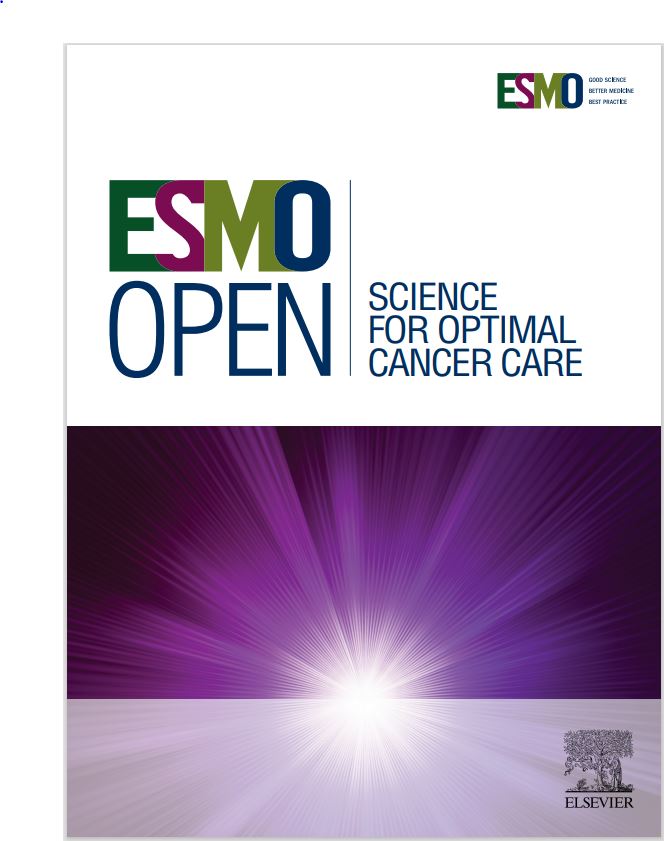在durvalumab联合新辅助化疗治疗早期三阴性乳腺癌的I/II期临床试验中,免疫相关不良事件与更好的无事件生存率相关
IF 7.1
2区 医学
Q1 ONCOLOGY
引用次数: 0
摘要
免疫相关不良事件(irAEs)与不同肿瘤预后的改善有关;然而,它们在三阴性乳腺癌(TNBC)的新辅助免疫检查点抑制剂治疗和化疗中的影响尚不清楚。患者和方法本分析包括来自耶鲁癌症中心及其区域护理中心的I/II期单臂临床试验的患者。该研究于2015年12月至2020年12月进行。符合条件的患者是年龄≥18岁、临床I-III期TNBC且需要全身化疗的成年人。患者接受durvalumab与nab-紫杉醇和剂量密集的阿霉素-环磷酰胺联合治疗。术后未给予杜伐单抗。我们研究了发生irAE与病理完全缓解(pCR = ypT0/is, ypN0)、残留癌症负担(RCB)、无事件生存期(EFS)和总生存期(OS)的关系。从手术时间开始进行具有里程碑意义的分析。结果67例患者符合毒理和疗效分析;其中27人有不同程度的irae, 13人有多重irae。中位随访时间为61个月(6.8-94.03个月)。最常见的irAEs是皮肤(n = 14)、内分泌(n = 13)和胃肠道(n = 5)。经历irAEs的患者的pCR或RCB 0-1率分别为56%和73%,而未经历irAEs的患者的pCR或RCB 0-1率分别为40%和55% (P = 0.309和0.19)。发生irAE也与显著改善的EFS相关[风险比(HR) 0.25;95%可信区间(CI) 0.09-0.66, P = 0.024)和OS改善趋势(HR 0.42;95% ci 0.14-1.27, p = 0.17)。有一个以上irAE的患者没有EFS事件。标志性分析结果相似(EFS HR 0.19, P = 0.014;OS hr 0.4, p = 0.16)。结论在接受新辅助免疫检查点治疗加化疗的患者中,irAE的发生与pCR率的数值提高、RCB的降低和EFS的显著升高有关。本文章由计算机程序翻译,如有差异,请以英文原文为准。
Immune-related adverse events are associated with better event-free survival in a phase I/II clinical trial of durvalumab concomitant with neoadjuvant chemotherapy in early-stage triple-negative breast cancer
Background
Immune-related adverse events (irAEs) have been associated with improved outcomes in different tumors; however, their impact during neoadjuvant immune checkpoint inhibitor therapy and chemotherapy in triple-negative breast cancer (TNBC) remains unknown.
Patients and methods
This analysis included patients from a phase I/II single-arm clinical trial at Yale Cancer Center and its regional care centers. The study was conducted from December 2015 to December 2020. Eligible patients were adults aged ≥18 years with clinical stage I-III TNBC for whom systemic chemotherapy was indicated. Patients received durvalumab concomitant with nab-paclitaxel and dose-dense doxorubicin–cyclophosphamide. Durvalumab was not administered post-operatively. We examined the association of developing an irAE with pathologic complete response (pCR = ypT0/is, ypN0), residual cancer burden (RCB), event-free survival (EFS), and overall survival (OS). A landmark analysis from the time of surgery was also carried out.
Results
A total of 67 patients were eligible for toxicity and efficacy analysis; of these, 27 had irAEs of any grade and 13 had multiple irAEs. The median follow-up was 61 months (range 6.8-94.03 months). The most frequent irAEs were dermatologic (n = 14), endocrine (n = 13), and gastrointestinal (n = 5). Patients who experienced irAEs achieved a pCR or RCB 0-1 rate of 56% and 73%, respectively, compared with 40% and 55% in those without irAEs (P = 0.309 and 0.19). Development of irAE was also associated with significantly improved EFS [hazard ratio (HR) 0.25; 95% confidence interval (CI) 0.09-0.66, P = 0.024] and a trend for improved OS (HR 0.42; 95% CI 0.14-1.27, P = 0.17). Patients with more than one irAE had no EFS events. The landmark analysis showed similar results (EFS HR 0.19, P = 0.014; OS HR 0.4, P = 0.16).
Conclusions
The development of irAE was associated with numerically improved pCR rates, lower RCB, and significantly higher EFS in patients treated with neoadjuvant immune checkpoint therapy plus chemotherapy.
求助全文
通过发布文献求助,成功后即可免费获取论文全文。
去求助
来源期刊

ESMO Open
Medicine-Oncology
CiteScore
11.70
自引率
2.70%
发文量
255
审稿时长
10 weeks
期刊介绍:
ESMO Open is the online-only, open access journal of the European Society for Medical Oncology (ESMO). It is a peer-reviewed publication dedicated to sharing high-quality medical research and educational materials from various fields of oncology. The journal specifically focuses on showcasing innovative clinical and translational cancer research.
ESMO Open aims to publish a wide range of research articles covering all aspects of oncology, including experimental studies, translational research, diagnostic advancements, and therapeutic approaches. The content of the journal includes original research articles, insightful reviews, thought-provoking editorials, and correspondence. Moreover, the journal warmly welcomes the submission of phase I trials and meta-analyses. It also showcases reviews from significant ESMO conferences and meetings, as well as publishes important position statements on behalf of ESMO.
Overall, ESMO Open offers a platform for scientists, clinicians, and researchers in the field of oncology to share their valuable insights and contribute to advancing the understanding and treatment of cancer. The journal serves as a source of up-to-date information and fosters collaboration within the oncology community.
 求助内容:
求助内容: 应助结果提醒方式:
应助结果提醒方式:


